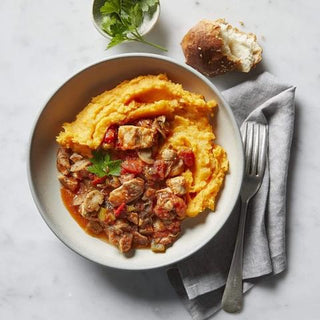
For some time now, we’ve known that certain foods can trigger particular gastrointestinal symptoms, but thanks to advancements in science and technology it’s now easier to pinpoint which types of ingredients and in what quantities cause such discomfort. FODMAPs can be particularly troublesome for those with hyperactive gut sensitivities. To find out exactly what is involved, here’s a beginners guide to understanding more about the Low FODMAP Diet.
What are FODMAPs?
In short, they are a group of poorly absorbed fermentable short chained carbohydrates that can lead to excessive fluid and gas production causing gastrointestinal discomfort (e.g. bloating, abdominal pain and distension in some people
FODMAP definition:
- Fermentable – carbohydrates that are broken down by microorganisms (bacteria) in the gut to produce an alcohol or organic acids
- Oligosaccharides – ‘oligo’ means a few individual sugars that are joined together
- Disaccharides – two sugar molecules
- Monosaccharides – one sugar molecule
- Polyols – sugar alcohols
Due to their smaller molecular size, FODMAPs draws in water causing an osmotic effect in the large intestine (this would be when diarrhoea comes into play). The carbohydrates that are poorly absorbed undergo fermentation in the large bowel producing hydrogen and methane gas which is the cause of bloating, excessive flatulence, abdominal pain and distension.
How does the diet work?Dietary restriction of FODMAPs or what is known as the low FODMAP diet has been shown to be an effective treatment for reducing IBS symptoms in 50-76% patients by reducing the fermentable load on the colon, thereby reducing gas production and the internal expansion/pressure of the lumen increasing abdominal size. To take the science out of it – less FODMAPs = less stress on the colon, less gas, pressure & discomfort1-6.
The diet follows a three-phase approach and is a temporary means for pinpointing which ingredients trigger symptoms in an individual.
It’s always recommended that you get guided assistance from an Accredited Practicing Dietitian (APD) who specialises in low FODMAP diets so they can tailor modifications for you without compromising on the nutritional adequacy of your diet. It is important to remember that everyone differs in their tolerance thresholds and that not everyone will experience symptoms with every type of FODMAP..
Common FODMAPSFODMAPs are found in a variety of foods8 with the main ones being:
- Dairy products like milk & soft cheeses
- Honey, apples, mango, high fructose corn syrup
- Onion, leek, garlic, wheat
- Legume beans, chickpeas, lentils
- Sorbitol, mannitol, xylitol
Low FODMAP Monash App uses a traffic light system to categorise foods into what can be eaten freely and which should be limited. ‘Red foods are those high in FODMAPS and should be avoided, orange foods are moderate in FODMAPs and may be tolerated by some and green foods are low in FODMAPs and safe for consumption’. Think of it as the master of all FODMAP databases… particularly because Monash basically invented the diet.
Alternatively, resources such as the Low FODMAP Diet Food Shopping Guide by Sue Shepherd or the FODMAP Friendly App are also useful.
- High FODMAP ingredients within a meal may not necessarily make it the meal as whole high FODMAP. For example, onion or garlic in small amounts that make up less than 5% of the total product may still be tolerable.
- Look for lactose-free dairy products but be wary of sweeteners such as honey, maple syrup or fruit flavours that are high in FODMAPs.
- Look for sourdough bread made from spelt flour or bread varieties that undergo the sourdough proving process. These breads contain lower amounts of fructan and gluten9 as the longer proving time allows the yeast and bacteria to feed on the FODMAPs.
- If following a vegetarian diet, legumes and beans are usually ones' main source of protein. However, this isn't ideal when in conjunction with a low FODMAP diet. You can get a great amount of FODMAP-friendly protein from tofu, eggs, nuts and seeds in small quantities (excluding pistachios and cashews), tempeh and wholegrains (such as quinoa, buckwheat).
- Beware of hidden FODMAPs such as onions, garlic, shallots which can be found in sauces, marinades & gravies. Keep in mind ‘common names’ that might be missed in the ingredients list such as vegetable powder or dehydrated vegetables.
So you’ve gone through the battle of the elimination phase, but still haven’t seen any improvements? If your gut is particularly sensitive, eating a combination of low FODMAP ingredients throughout the day may still be triggering symptoms, something that is referred to as ‘stacking’.
Stacking occurs when you eat multiple quantities of one or more low FODMAP foods that come from the same FODMAP group whether in a single meal or close together. These FODMAPs can then accumulate and trigger symptoms. It goes without saying that this diet is largely dose-dependent- meaning serving size is particularly crucial. This is why regular assessments to understand your threshold is a must!
Gluten Free vs Low FODMAPGluten is a protein found in wheat, rye, barley and oats whereas FODMAPs are carbohydrates. Although the low FODMAP diet counters for a lot of carbohydrate sources that contain gluten, gluten free products are not necessarily also low FODMAP. For example, chickpea flour, inulin (a common starchy carbohydrate found in chicory root) and honey may be commonly found in gluten free items but are considered high FODMAP ingredients. As labelling laws require wheat to be declared as an allergen some ingredients such as wheat starch, wheat maltodextrin and wheat glucose are usually acceptable. Soy sauce containing wheat is also low FODMAP at 2 tablespoons per serve, which is more than enough for seasoning.
Dineamic Low FODMAP MealsBefore you get stuck into the low FODMAP diet, we highly suggest talking to a health practitioner first. If you have been advised to follow a low FODMAP diet, Dineamic provide a range of Low FODMAP meals created according to the Monash guidelines without the use of garlic or onion in any of the meals.
References
- Bohn L, Storsrud S, Liljebo T, et al. Diet low in FODMAPs reduces symptoms of irritable bowel syndrome as well as traditional dietary advice: a randomized controlled trial. Gastroenterology. 2015;149:1399‐1407.
- Halmos EP, Power VA, Shepherd SJ, Gibson PR, Muir JG. A diet low in FODMAPs reduces symptoms of irritable bowel syndrome. Gastroenterology. 2014;146(67–75):e65.
- Ong DK, Mitchell SB, Barrett JS, et al. Manipulation of dietary short chain carbohydrates alters the pattern of gas production and genesis of symptoms in irritable bowel syndrome. J Gastroenterol Hepatol. 2010;25:1366‐1373.
- Shepherd SJ, Gibson PR. Fructose malabsorption and symptoms of irritable bowel syndrome: guidelines for effective dietary management. J Am Diet Assoc. 2006;106:1631‐1639.
- Staudacher HM, Lomer MC, Anderson JL, et al. Fermentable carbohydrate restriction reduces luminal bifidobacteria and gastrointestinal symptoms in patients with irritable bowel syndrome. J Nutr. 2012;142:1510‐1518.
- Halmos EP, Christophersen CT, Bird AR, Shepherd SJ, Gibson PR, Muir JG. Diets that differ in their FODMAP content alter the colonic luminal microenvironment. Gut. 2015;64:93‐100.
- Monash University. Monash FODMAP. https://www.monashfodmap.com/blog/3-phases-low-fodmap-diet/
- Magge, S & Lembo A. Low FODMAP Diet for Treatment of Irritable Bowel Syndrome. Gastroenterol Hepatol (N Y) 2012 8(11): 739-745
- Monash University. Monash FODMAP. https://www.monashfodmap.com/blog/sourdough-processing-fodmaps/





